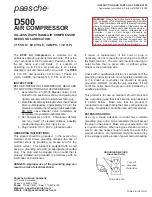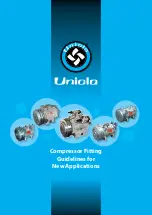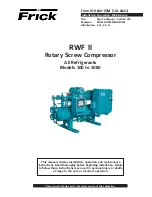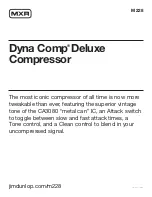
4
FRCC.EI.003.A1.02 © Danfoss Commercial Compressors 03/08
Instructions
to compressor terminals T1, T2, T3 to avoid
reverse rotation.
• Use ø 4.8 mm (3/16”) screws and ¼” ring ter
-
minals for the power connection. Fasten with
3 Nm torque.
• The thermostat connection (if present) is a ¼”
AMP-AWE spade connector.
• The compressor must be connected to earth
with the 5 mm earth terminal screw.
8 – Filling the system
• Keep the compressor switched off.
• SM 084 to 185, SY 380, SZ 084 to 185, SZ 380, SH
090 to 180: Fill the refrigerant in liquid phase
into the condenser or liquid receiver. The char-
ge must be as close as possible to the nominal
system charge to avoid low pressure operation
and excessive superheat. Never let the pressure
on LP side exceed the pressure on HP side with
more than 5 bar. Such pressure difference could
cause internal compressor damage.
• SY 240 & 300, SZ 240 & 300, SH 240 to 380: Fill
the refrigerant slowly in liquid phase into the
LP side of the system. The charge must be as
close as possible to the nominal system charge
to avoid low pressure operation and excessive
superheat. The pressure increase from 0 up
to the full system charge shall take at least 2
minutes. When the 2 minutes time span is not
respected, the pressure on LP side could ex-
ceed the pressure on HP side with more than
5 bar and cause internal compressor damage.
• Keep the refrigerant charge below the indica
-
ted charge limits if possible. Above this limit;
protect the compressor against liquid flood-
back with a pump-down cycle or suction line
accumulator.
• Never leave the filling cylinder connected to
the circuit.
Compressor models
Refrigerant charge
limit (kg)
SM/SZ 084, 090, 100
8.5
SM/SZ 110, 120
10
SM/SZ 115, 125
11
SM/SZ 148, 160, 161
12.5
SM/SZ 175, 185
13.5
SY/SZ 240
16
SY/SZ 380
20
SH 090
5.9
SH 105, 120, 140, 161
7.9
SH 180, 240, 300
13.5
SH 380
14.5
9 – Verification before commissioning
Use safety devices such as safety pressure
switch and mechanical relief valve in complian-
ce with both generally and locally applicable re-
gulations and safety standards. Ensure that they
are operational and properly set.
Check that the settings of high-pressure swit-
ches and relief valves don’t exceed the maximum
service pressure of any system component.
• A low-pressure switch is recommended to
avoid vacuum operation. Minimum setting
for SM/SY/SZ: 1.5 bar (absolute). Minimum
setting for SH: 1.6 bar (absolute).
• Verify that all electrical connections are pro
-
perly fastened and in compliance with local
regulations.
• When a crankcase heater is required, it must be
energized at least 12 hours before initial start-
up and start-up after prolonged shutdown.
Exception: Due to specific R410A behavior it
is not recommended to energize crankcase
heaters on SH compressors before initial
startup.
10 – Start-up
• Never start the compressor when no refrige
-
rant is charged.
• All service valves must be in the open position.
• Balance the HP/LP pressure.
• Energize the compressor. It must start prompt
-
ly. If the compressor does not start, check wi-
ring conformity and voltage on terminals.
• Eventual reverse rotation can be detected
by following phenomena; the compressor
doesn’t build up pressure, it has abnormally
high sound level and abnormally low power
consumption. In such case, shut down the
compressor immediately and connect the
phases to their proper terminals. Most Per-
former® scroll compressors are protected
against reverse rotation either by an internal
reverse rotation protection or by the external
electronic protection module. They will shut
off automatically. Only SH 090 to 161 and SM
124, 147 have no reverse rotation protection.
Prolonged reverse rotation over 6 hours will
damage these compressors.
• If the internal overload protector trips out (SM/
SZ 084, 090, 100, 110, 120, 124, 147, 148, 161
and SH 090, 105, 120, 140, 161), it must cool
down to 60°C to reset. Depending on ambient
temperature, this may take up to several hours.
• If the internal pressure relief valve is opened
(SY/SZ 240, 300, 380 and SH 380), the com-
pressor sump will be warm and the compres-
sor will trip out on the motor protector.
11 – Check with running compressor
• Check current draw and voltage.
• Check suction superheat to reduce risk of
slugging.
• Observe the oil level in the sight glass for
about 60 minutes to ensure proper oil return
to the compressor.
• Respect the operating limits.
• Check all tubes for abnormal vibration. Move
-
ments in excess of 1.5 mm require corrective
measures such as tube brackets.
• When needed, additional refrigerant in liquid
phase may be added in the low-pressure side as
far as possible from the compressor. The com-
pressor must be operating during this process.
• Do not overcharge the system.
• Never release refrigerant to atmosphere.
• Before leaving the installation site, carry out
a general installation inspection regarding
cleanliness, noise and leak detection.
• Record type and amount of refrigerant charge
as well as operating conditions as a reference
for future inspections.
12 – Maintenance
Internal pressure and surface temperature
are dangerous and may cause permanent injury.
Maintenance operators and installers require
appropriate skills and tools. Tubing temperature
may exceed 100°C and can cause severe burns.
Ensure that periodic service inspections to
ensure system reliability and as required by local
regulations are performed.
To prevent system related compressor problems,
following periodic maintenance is recommended:
• Verify that safety devices are operational and
properly set.
• Ensure that the system is leak tight.
• Check the compressor current draw.
• Confirm that the system is operating in a way
consistent with previous maintenance re-
cords and ambient conditions.
• Check that all electrical connections are still
adequately fastened.
• Keep the compressor clean and verify the ab
-
sence of rust and oxidation on the compres-
sor shell, tubes and electrical connections.
13 - Warranty
Always transmit the model number and serial num-
ber with any claim filed regarding this product.
The product warranty may be void in following
cases:
• Absence of nameplate.
• External modifications; in particular, drilling,
welding, broken feet and shock marks.
• Compressor opened or returned unsealed.
• Rust, water or leak detection dye inside the
compressor.
• Use of a refrigerant or lubricant not approved
by Danfoss.
• Any deviation from recommended instruc
-
tions pertaining to installation, application or
maintenance.
• Use in mobile applications.
• Use in explosive atmospheric environment.
• No model number or serial number transmit
-
ted with the warranty claim.
14 – Disposal
Danfoss recommends that compressors
and compressor oil should be recycled
by a suitable company at its site.






















